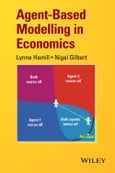Agent-based modelling in economics
Lynne Hamill and Nigel Gilbert, Centre for Research in Social Simulation (CRESS), University of Surrey, UK
New methods of economic modelling have been sought as a result of the global economic downturn in 2008.This unique book highlights the benefits of an agent-based modelling (ABM) approach. It demonstrates how ABM can easily handle complexity: heterogeneous people, households and firms interacting dynamically. Unlike traditional methods, ABM does not require people or firms to optimise or economic systems to reach equilibrium. ABM offers a way to link micro foundations directly to the macro situation.
Key features:
- Introduces the concept of agent-based modelling and shows how it differs from existing approaches.
- Provides a theoretical and methodological rationale for using ABM in economics, along with practical advice on how to design and create the models.
- Each chapter starts with a short summary of the relevant economic theory and then shows how to apply ABM.
- Explores both topics covered in basic economics textbooks and current important policy themes; unemployment, exchange rates, banking and environmental issues.
- Describes the models in pseudocode, enabling the reader to develop programs in their chosen language.
- Supported by a website featuring the NetLogo models described in the book.
Agent-based Modelling in Economics provides students and researchers with the skills to design, implement, and analyze agent-based models. Third year undergraduate, master and doctoral students, faculty and professional economists will find this book an invaluable resource.
Table of Contents
Preface viii
Copyright notices ix
1 Why agentÂ]based modelling is useful for economists 1
1.1 Introduction 1
1.2 A very brief history of economic modelling 1
1.3 What is ABM? 4
1.4 The three themes of this book 5
1.5 Details of chapters 6
References 9
2 Starting agentÂ-based modelling 11
2.1 Introduction 11
2.2 A simple market: the basic model 12
2.3 The basic framework 13
2.4 Enhancing the basic model: adding prices 18
2.5 Enhancing the model: selecting traders 21
2.6 Final enhancement: more economically rational agents 23
2.7 Running experiments 25
2.8 Discussion 26
Appendix 2.A The example model: full version 27
References 28
3 Heterogeneous demand 29
3.1 Introduction 29
3.2 Modelling basic consumer demand theory 30
3.3 Practical demand modelling 39
3.4 Discussion 43
Appendix 3.A How to do it 46
References 52
4 Social demand 53
4.1 Introduction 53
4.2 Social networks 53
4.3 Threshold models 56
4.4 Adoption of innovative products 62
4.5 Case study: household adoption of fixedÂ-line phones in Britain 64
4.6 Discussion 70
Appendix 4.A How to do it 70
References 78
5 Benefits of barter 80
5.1 Introduction 80
5.2 OneÂ-toÂ-one barter 81
5.3 Red Cross parcels 88
5.4 Discussion 96
Appendix 5.A How to do it 97
References 104
6 The market 105
6.1 Introduction 105
6.2 Cournot–Nash model 105
6.3 Market model 108
6.4 Digital world model 117
6.5 Discussion 124
Appendix 6.A How to do it 125
References 131
7 Labour market 132
7.1 Introduction 132
7.2 A simple labour market model 142
7.3 Discussion 151
Appendix 7.A How to do it 155
References 161
8 International trade 163
8.1 Introduction 163
8.2 Models 172
8.3 Discussion 183
Appendix 8.A How to do it 185
References 187
9 Banking 189
9.1 Introduction 189
9.2 The banking model 198
9.3 Discussion 206
Appendix 9.A How to do it 209
References 212
10 Tragedy of the commons 214
10.1 Introduction 214
10.2 Model 218
10.3 Discussion 225
Appendix 10.A How to do it 228
References 232
11 Summary and conclusions 234
11.1 Introduction 234
11.2 The models 234
11.3 What makes a good model? 237
11.4 Pros and cons of ABM 238
References 239
Index 242








